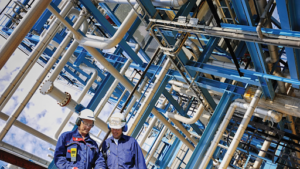In today’s industrial environment, creating an efficient and reliable automated facility is crucial. Without proper automation management, you risk increased downtime, mismanaged inventories, and operational inefficiencies.
IBE (Installed Base Evaluation) by Rockwell Automation is a service in the industrial space that can save you from operation inefficiency. It provides a clear, actionable overview of your installed base by covering everything from critical hardware to spare parts. This can help you optimize your assets, reduce risks, and plan strategically for future upgrades to your facility.

Source: Rockwell Automation
At HESCO, we know that every piece of hardware within your facility plays a vital role in keeping your operations running smoothly. Our team can assist in performing an IBE that not only helps you gain insights into your current inventory but also helps set the foundation for operational success.
This article is going to explore everything you need to know about an IBE and why it can be extremely beneficial for your facility to invest in.
Overview of the IBE Process
Before we dive into the nitty-gritty details of an IBE in your facility, we must define what it is.
An IBE (Installed Base Evaluation) is an evaluation performed to help you gain a complete understanding of the automation assets that are currently in your facility. This process is divided into two main stages: the site visit and data collection, followed by post-collection analysis.
Site Visit and Data Collection
Whether it is a team from HESCO or another distributor of Rockwell Automation products, some experts will head to your facility to catalog all the hardware that forms the backbone of your operations.
This hardware is referred to as the “installed base”. Whether it is currently on the floor being used, or in a storage room as a spare part, every single piece of hardware will be cataloged. By doing this, you can get a clear and complete picture of your preparedness for potential equipment failures or any need for replacements.
Think of the site visit as a checklist exercise – the team assesses the conditions of the hardware and notes any environmental issues that can affect the equipment’s longevity in the facility. Any wiring, ground, and networking concerns are noted to ensure safe and efficient operations in the facility. Finally, the team will check any Arc Flash stickers, as they are critical components for compliance with safety regulations.
Based on the site visit, a detailed installed base is created which contains hardware on the plant floor and spare parts in the storeroom.
Post-Collection Analysis
After the site visit is completed, the process moves to the post-collection analysis phase.
The analysts will begin to digest the information gathered during the site visit. This involves attributing each piece of hardware and spare part with its lifecycle status. This is done because it identifies which components are at risk of causing operational disruptions due to obsolescence or lack of available spare products.
There is also a detailed assessment done of the spares inventory, where any gaps in critical spares are reported as well as any excess or inactive inventory.
After the analysis is complete, the findings are compiled into one report, providing you with actual insights and recommendations. Not only do these reports give you areas of potential downtime risks, but they also offer a roadmap of suggestions to improve your operational efficiency.
In general, this approach is beneficial to your facility, as it will provide you with a clear and detailed understanding of your automation assets. Both of these steps are designed to help equip you with the knowledge you need for the future of your facility.
Key Insights and Outcomes from IBE

Source: Rockwell Automation
So, we went over how IBE works and the process of gaining insights into the plans for your facility. But, what exactly are the outcomes of the IBE? Key insights and outcomes from an IBE include:
- Spare Parts Optimization
One major benefit is the ability to optimize your spare parts inventory. Identifying missing critical spares and highlighting areas where inventory is excessive or non-existent helps lead to better inventory management.
- Lifecycle Status Attribution
The IBE assigns a lifecycle status to each component. This information helps to manage risks by identifying outdated parts or parts that are approaching end of life, allowing for easy planning of replacements or upgrades.
- Risk Assessment for Legacy Products
Risks linked to legacy products, particularly those without available spare or support, are an insight that is extremely valuable to you. Legacy products are products that are discontinued or at the end of life. These components can become weak points for your system, especially if they fail. The IBE helps to prioritize which parts should be modernized to prevent disruptions.
- Guidance on Future Upgrades
With the insights gathered from the IBE, you will be given strategic guidance where you can make informed decisions about the future. It can help you decide where to invest in new equipment and which outdated parts should be replaced first. This will ensure that your investments are aligned with the goals and the future of technology.
Overall, an IBE helps to optimize current operations and provide essential knowledge for future planning, from avoiding downtime to preparing for modernization.
Challenges and Considerations of an IBE
However, there are some challenges and considerations that you may face as you consider investing in an IBE.
Cost
Since this service costs money, you must know how much money you will be investing before considering getting an IBE.
Depending upon the number of panels and types of products that are being evaluated in your facility, it will vary. The lowest side of the range we see is about $4,000 and it could even go up to $50,000. But, the average cost of an IBE is around $6,000.
Though they can cost you more money if you have more products being evaluated, in the end it will save you more money because you are preparing for the future. Think of your facility – how much does a day of downtime cost for you? If an IBE can save you from that downtime cost by identifying missing spares, would you invest?
Alignment of Expectations
It is so important for you to align your expectations with the expectations of the team performing the IBE. Without discussing what outcomes you are looking for, there may be some questions left unanswered.
To ensure this is not an issue, the team will send out a pre-evaluation questionnaire, going over all of your expectations. This helps give them insights into creating a successful game plan.
Site Visit Requirements
When the site visit is performed, a chaperone from your facility must be there to guide the evaluator. Though you are in the facility every day, the evaluator has likely not been there before, so they must be comfortable with what they are evaluating and can gain some insight into the facility throughout the evaluation.
Though there are a few challenges and considerations, there are not many. IBEs are a great investment for your facility to ultimately enhance its operational efficiency.
Outcomes Achieved by Automation Customers
IBE delivers tangible results that significantly impact a facility’s operations. Here’s why it’s so helpful, directly from experiences with customers at HESCO:
Downtime Prevention
One of the most crucial outcomes of an IBE is the prevention of unexpected downtime. By identifying gaps in spare parts and assessing the condition of critical equipment, you can address potential issues before they lead to costly shutdowns. This approach keeps operations running smoothly and reduces the risk of production delays.
Inventory Efficiency
IBE helps you streamline inventory, ensuring you have the right parts on hand without overstocking. By eliminating excess inventory and filling gaps in critical spares, you can reduce waste and free up capital that would otherwise be tied up in unnecessary stock. This leads to a more efficient and cost-effective inventory management system.
Strategic Modernization
You will benefit from clear, data-driven guidance on where to invest in upgrades and replacements. The IBE pinpoints which equipment is outdated or at risk of failure, allowing clients to prioritize modernization efforts where they will have the most impact. This strategic planning helps future-proof operations and ensures that investments are made wisely.
Long-Term Savings
By optimizing assets and planning for future needs, you will see significant long-term savings. Reducing downtime, managing inventory more effectively, and making informed decisions about upgrades all contribute to lower operational costs and increased efficiency over time.
In short, the outcomes achieved through an IBE have empowered our customers and will empower you to take control of automation assets. It’s a smart investment in the future of your facility.
Don’t Let Operational Inefficiencies Hold Your Facility Back
Investing in an IBE is a strategic move towards enhancing your facility’s operational efficiency and future-proofing your automation. By gaining an understanding of your installed base, you can optimize spare parts inventory, mitigate risks associated with legacy products, and make informed decisions about future upgrades.
HESCO is uniquely positioned to assist you in this crucial process. Our team of experts can conduct a thorough IBE tailored to your facility’s specific needs. We understand the intricacies of industrial automation and can provide valuable insights to help you maximize the benefits of this evaluation.
Don’t let operational inefficiencies hold your facility back. Contact us today to learn more about IBEs. Let HESCO guide you toward a more efficient, reliable, and future-ready facility.
